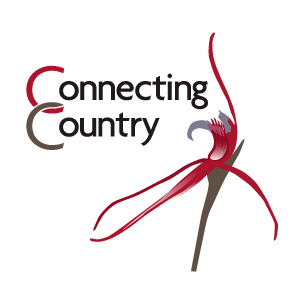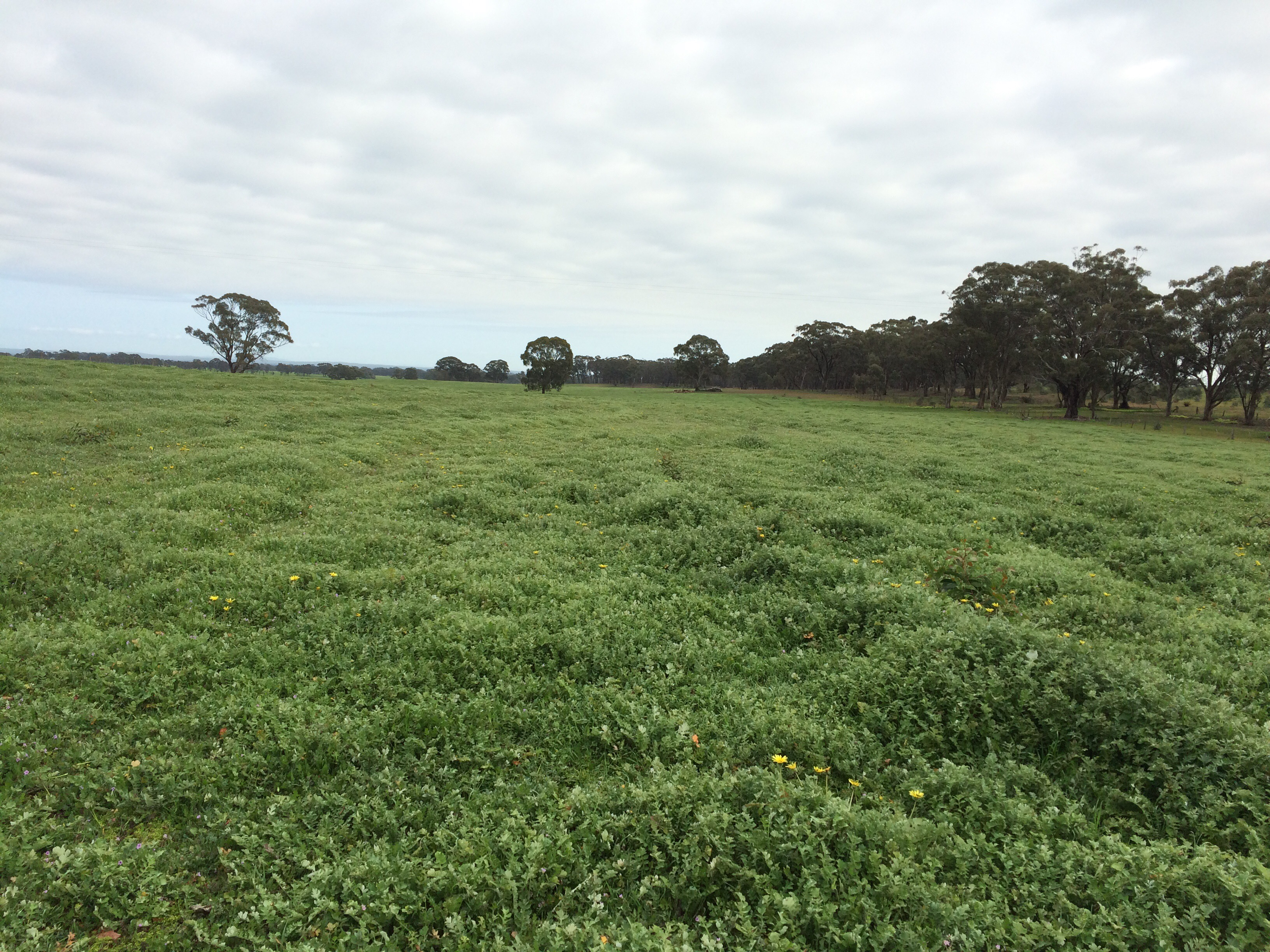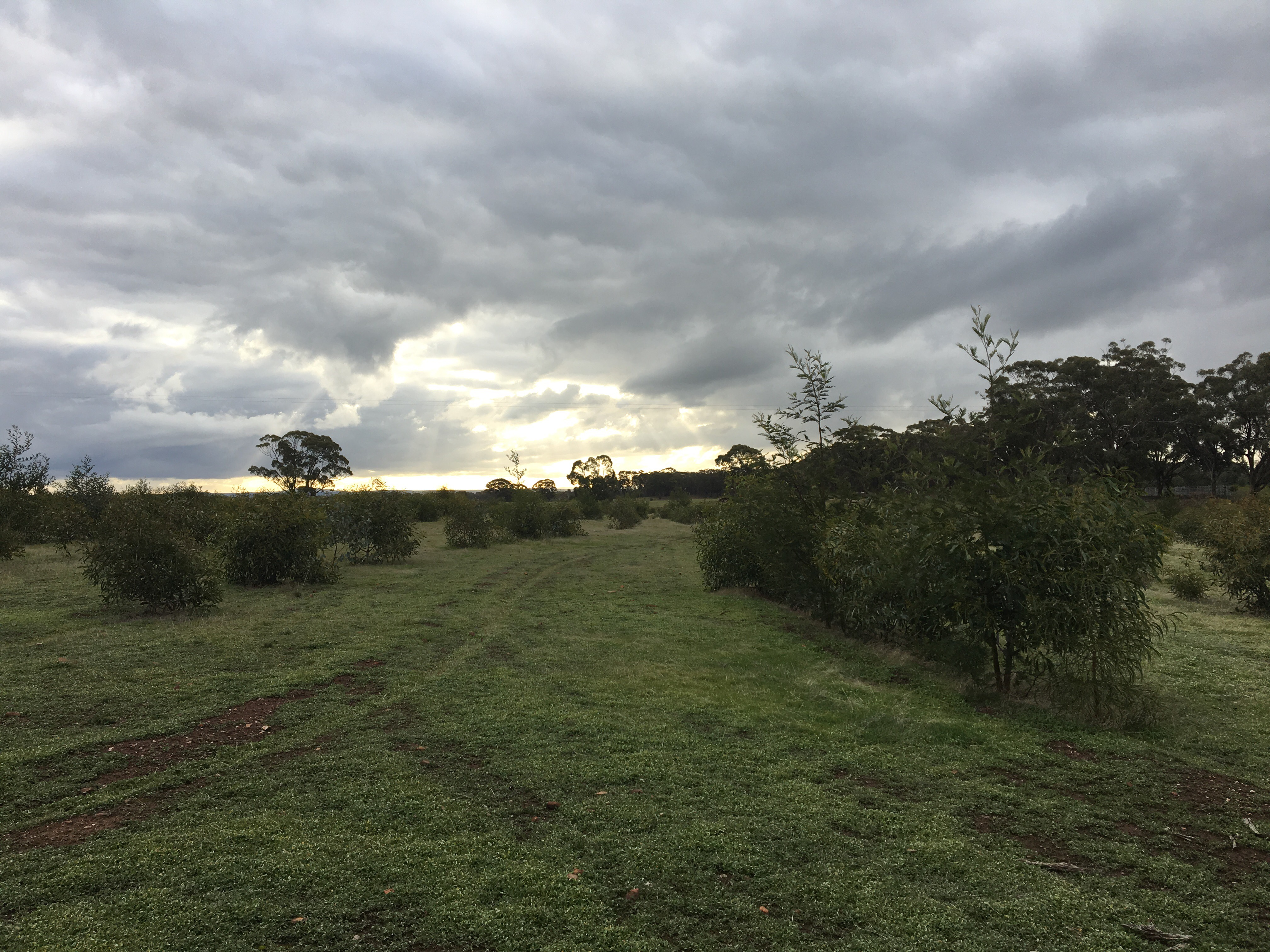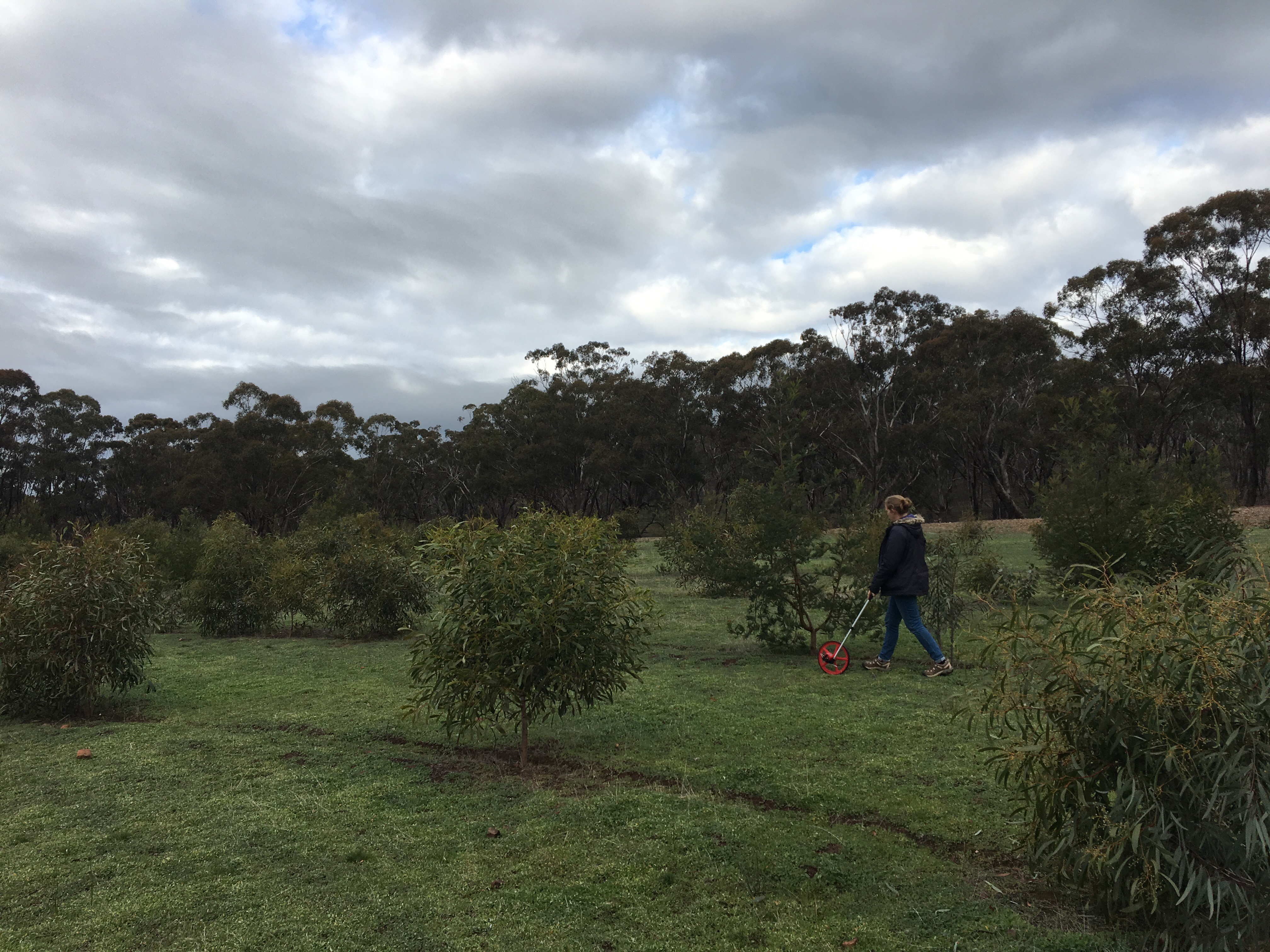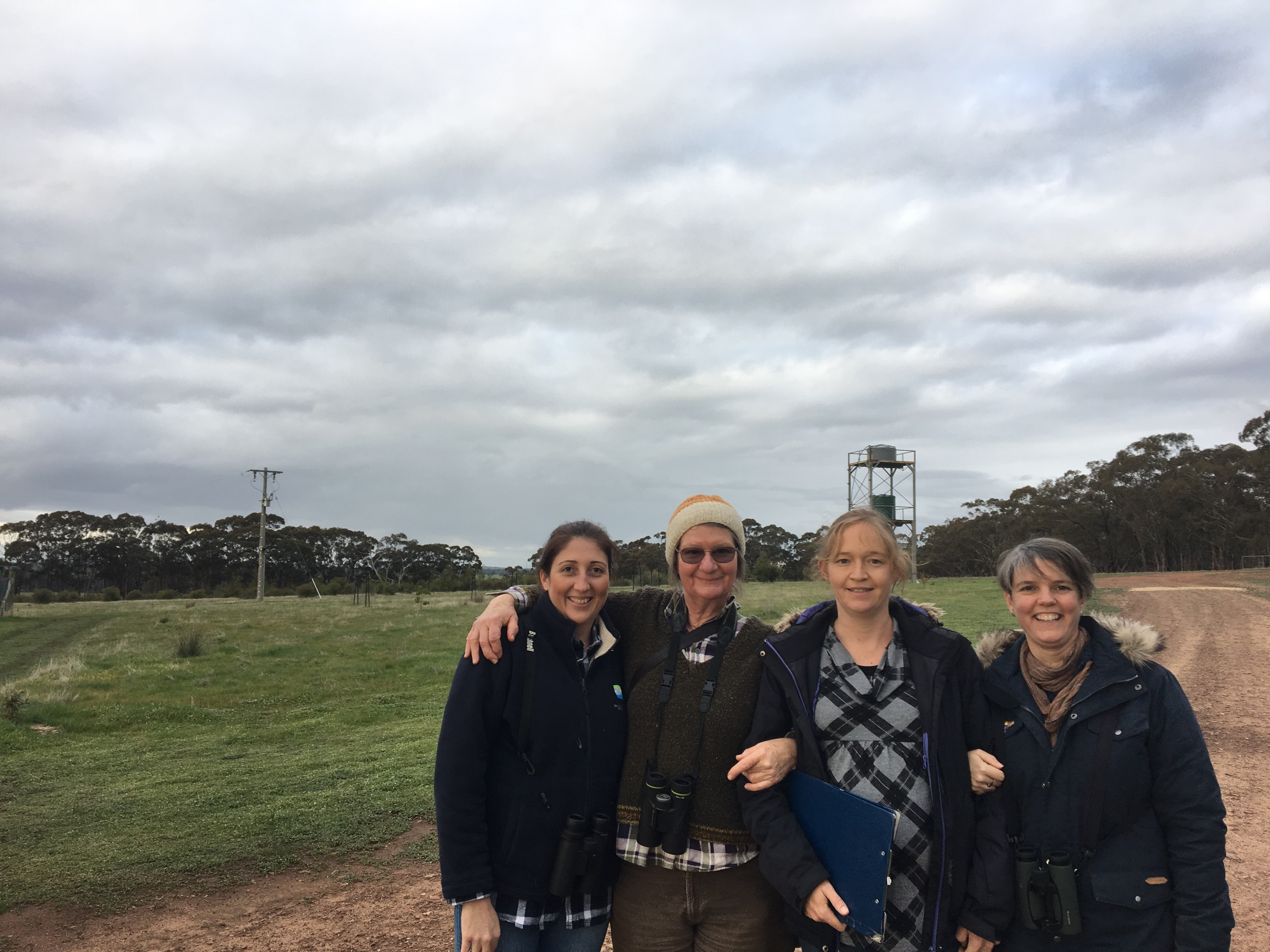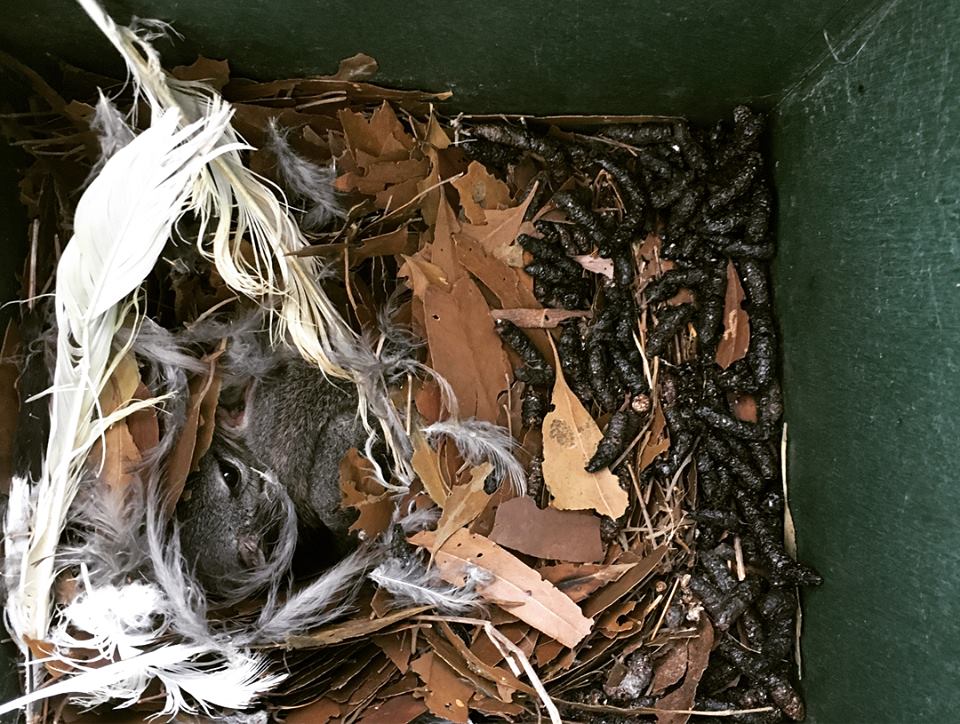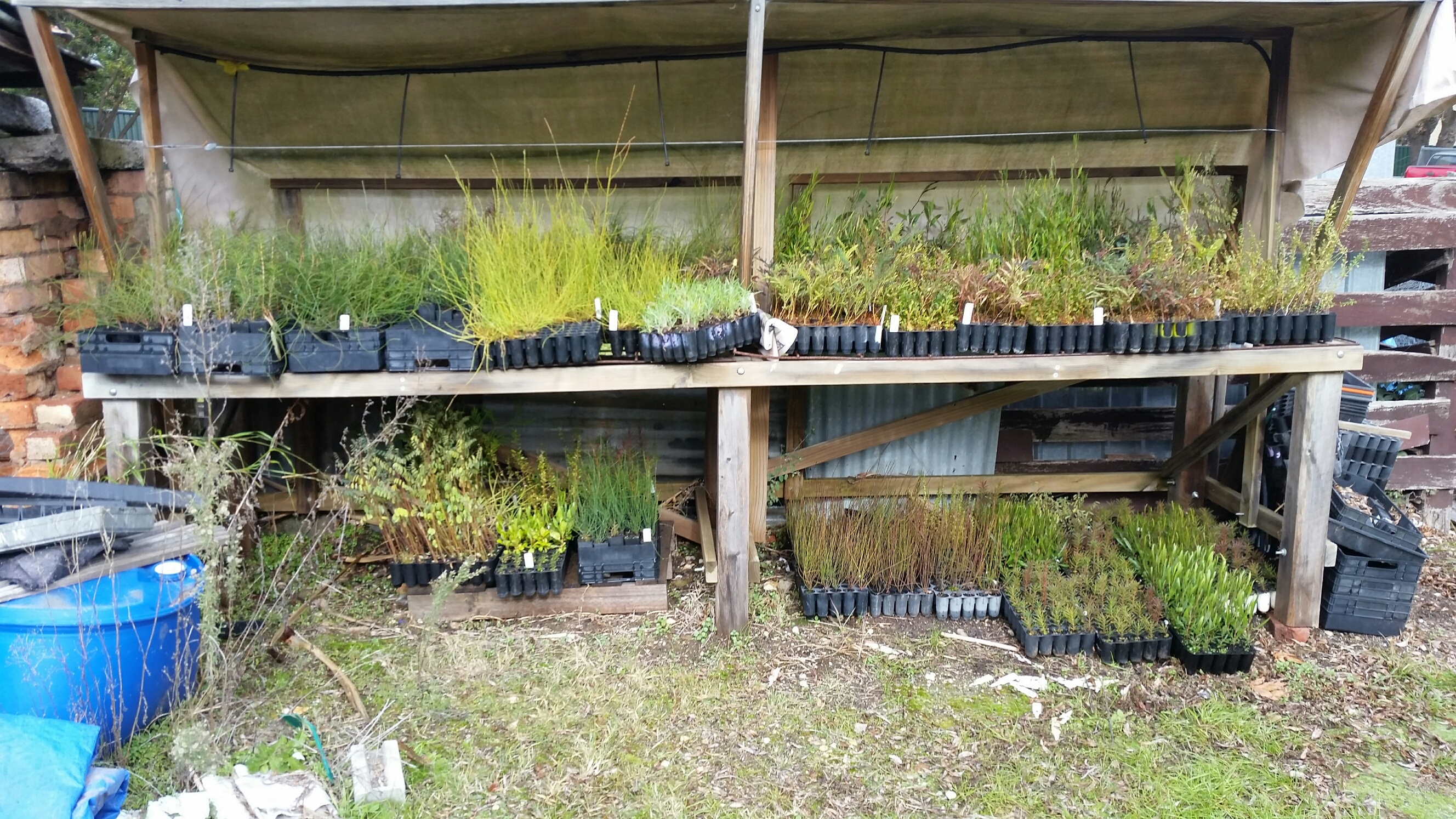Small bush bird habitat created at Bradford!
Posted on 30 July, 2018 by Tanya Loos
What a difference a couple of years makes! Last Thursday, 26 July 2018, Bonnie, Frances and Tanya had the great pleasure of visiting Kerri Peacoulakis’ property in Bradford to marvel at the growth of native plant species at their direct seeding site, and also chat about bird surveying. Below is a photo of part of the site taken in September 2016, about one year after direct seeding.
Below is the same site, taken in the same direction. Note the large eucalypt with the wide crown in the left hand side of the photo.
The site was direct seeded in 2015, as part of Connecting Country’s Habitat for Bush Birds project. It is amazing to think that there are many tiny young plants fighting for survival under all the prolific capeweed in the first photo! The site is a bird survey site called NW-PR-03, a northwest paddock revegetation site. The direct seeding is even more successful looking in the other direction, towards the Blue Hills area.
In the above photo, Bonnie is using a trundle wheel and a counter to carry out a direct seeding success count. These counts measure how many plants have grown, giving a standard measure of trees/shrubs per metre count. This number is comparable from site to site, and enables us here at Connecting Country to monitor the growth of our direct seeding from year to year.
The plant species in the direct seeding included a mix of local wattles, eucalypts, she-oaks, hop bush, and hakeas.
Kerri is taking on the bird survey site, by surveying the site four times per year. During our visit, we conducted a 20 minute 2 hectare count, with Kerri entering the data on her Birdata app on her smartphone. So simple! During the survey, we saw many open country species such as Red-rumped parrots, Welcome swallows and Australian magpies. Kerri said that she had observed Superb fairy-wrens on the site – a true mark of success as these little birds are NEVER recorded in a bare, open paddock! Well done Kerri and also her partner Tusker and family for a fantastic project!
Come planting with Friends of Campbells Creek Landcare – National Tree Day
Posted on 26 July, 2018 by Asha
Each year Friends of Campbells Creek takes part in two important Australia-wide events. One is Clean up Australia Day, held earlier in the year. The other is National Tree Day, which will be held next Sunday (29 July 2018). National Tree Day brings communities together to re-establish native vegetation all across the nation.
The Friends will be planting at two sites along the creek, possibly three if we have enough people attending. There will be a free BBQ lunch afterwards. The group would love to see you there!
Details are as follows:
The plan: We’ll be planting trees, shrubs and robust herbs like Lomandras to accentuate one of the main entrances to the Campbells Creek trail.
When: Meet at 10:00 am on Sunday 29 July at the outdoor environment classroom (the colourful tables and benches). We’ll finish around mid-day with a BBQ.
Get there: Park outside the Campbells Creek Park in Main Road, Campbells Creek, opposite the hardware store. Follow the winding concrete path westwards towards the creek and then walk upstream along the creek track, crossing the footbridge and continuing for another 70 metres. OR: Park in Elizabeth Street 40 metres north of Cemetery Road and walk 150 metres east along the feeder track (you can drive in but there’s limited parking space in the reserve).
Bring: Hats, gloves, sturdy clothing, enclosed footwear, protection suitable for the weather, and your own water. With rain forecast in the preceding week, gumboots might be useful.
For more information, get in touch Friends of Campbells Creek Landcare
Contact: Thea King
Tel: 0421 656 643
Email: info@focc.org.au
Website: https://www.landcarevic.org.au/groups/northcentral/focg/
Nest box adventures: a community effort in 2018
Posted on 19 July, 2018 by Asha
In May 2018, Connecting Country once again completed monitoring of our nest boxes. This was the fourth time we’ve checked the boxes since they were installed the Mount Alexander region in 2010/11. This year, we were lucky enough to have help from Beth Mellick from the Wettenhall Environment Trust and Jess Lawton from Latrobe University.
Beth, Jess, and Asha tag-teamed going out with many fabulous volunteers to check the 300 nest boxes that are part of CC’s official monitoring program. For each box, we recorded information about which species were using it, either by identifying a living animal or by looking at the nest in the box.
The boxes were installed to provide crucial habitat for Brush-tailed Phascogales, but they also attract other animals like Sugar Gliders and invasive Honeybees. We also collected data to update our existing information on the box’s context in the environment (tree size, tree species, patch size, etc.). We are working on inputting all of this data into our database for analysis so we can compile a report with some results to share.
Thank you to all of the amazing people who volunteered their time to help this year: Jeremy, Lori, Naomi, Bev, Paul, Gayle, Carmen, Mal, Damian, Frances, Lachlan, and Meg. A big thank you also to the hundred or so landholders who continue to host our nest boxes on their property, and allow us access for monitoring.
Special thanks go to Beth, Jess, the Wettenhall Environment Trust, and Latrobe University for their support and for making this year’s nest box monitoring possible.
For more information about Connecting Country’s nest boxes and past monitoring, CLICK HERE.
It’s planting season! Understorey enhancement underway…
Posted on 17 July, 2018 by Tanya Loos
It is the height of winter, and the peak planting season is drawing to a close. We’re very happy to be distributing plants to landholders participating in our on-ground works projects. The plants pictured below are a range of native understorey plants that will add diversity and habitat quality to existing remnant vegetation.
Landholders involved in our ‘Prickly Plants for Wildlife’ project are planting their own plants. Landholders from our ‘Woodland Bird Habitat’, ‘Remnant Rescue’ or ‘Biodiversity On-ground Action’ projects are receiving assistance from the Dja Dja Wurrung works crew, known as Djandak. These projects are made possible by funding from the Victorian Department of Environment, Land, Water and Planning, and the North Central Catchment Management Authority.
Young plants need protection while they get established. Previously we used milk carton guards and bamboo stakes in our planting programs. Now we use coreflute guards and hardwood stakes, as these provide more protection against grazing wallabies, and are less likely to get knocked over by commuting kangaroos.

The Little Habitat Heroes planting site on Mount Alexander, by the old silkworm farm. Coreflute guards and stakes have worked very well on this site, resulting in high rates of plant survival.
Connecting Country is always looking for landholders interested in protecting native vegetation and wildlife habitat on their properties. Check out the on-ground works section of our website for more information, and to download an Expression of Interest form.
Bird and Frog App workshop – Sunday 15 July 2018
Posted on 12 July, 2018 by Asha
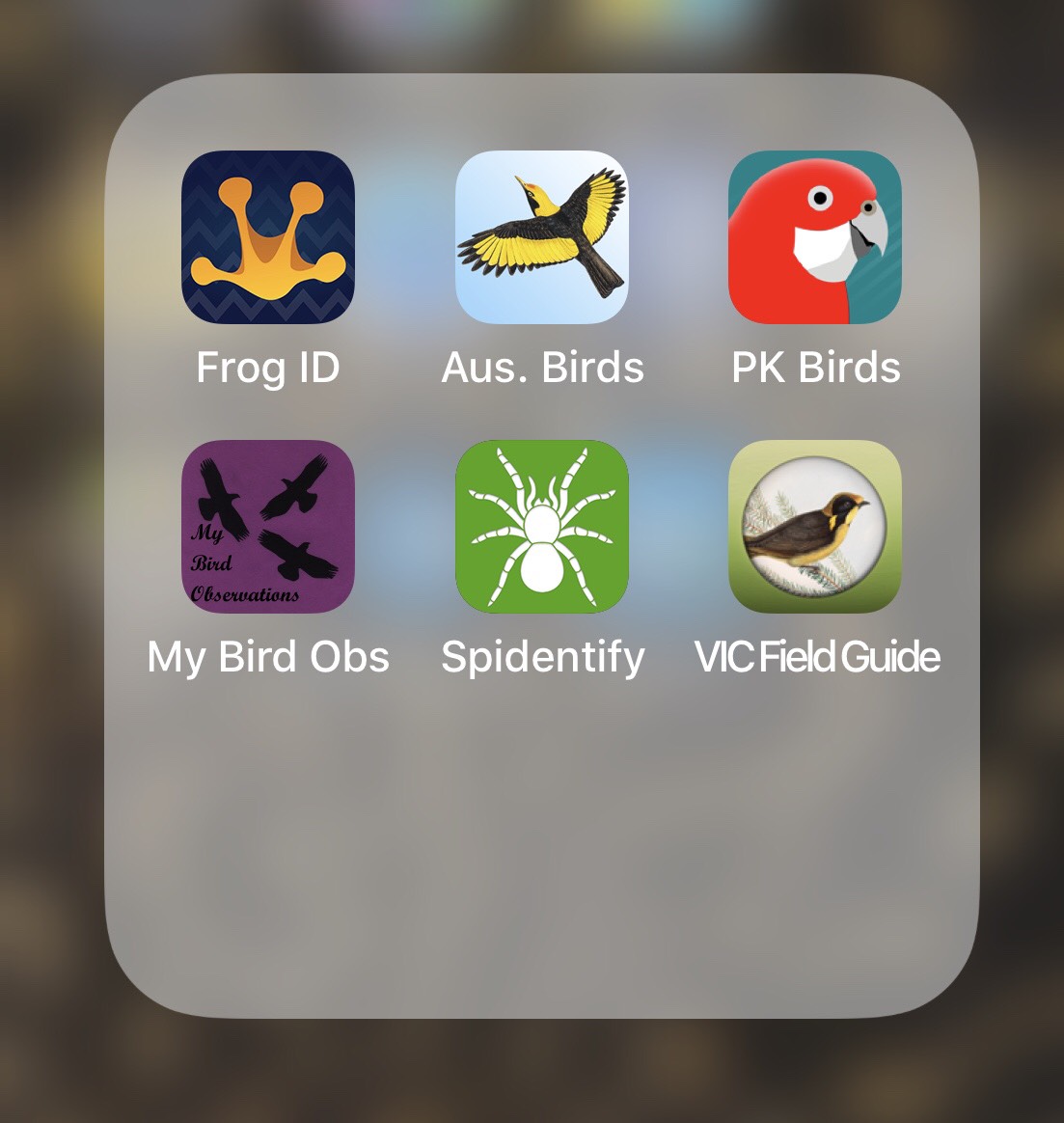 Muckleford Landcare’s Bird and Frog App Workshop is this Sunday 15 July 2018, at 1.30 pm, in Maldon.
Muckleford Landcare’s Bird and Frog App Workshop is this Sunday 15 July 2018, at 1.30 pm, in Maldon.
You will need to come along with a smart device or tablet with the following apps downloaded: Birdata and Frog ID. Another good app is the Vic Field Guide from Museum Victoria. The workshop will cover how to use the apps and how to upload data to national databases.
All are welcome. You can RSVP by emailing Beth Mellick (Muckleford Landcare Secretary) at bethmellick@gmail.com, or sending a text to 0431219980 and they’ll send you the address.
Come and hear about Scientific monitoring at Connecting Country: a community effort – Friday 13 July 2018
Posted on 12 July, 2018 by Tanya Loos
Castlemaine Field Naturalists Club is hosting a guest speaker, our very own Tanya Loos, talking about Scientific monitoring at Connecting Country: a community effort.
Woodland birds, arboreal mammals, frogs and reptiles – what can these critters tell us about landscape health? Tanya Loos, Connecting Country’s Monitoring and Engagement Coordinator, talks about the organisation’s long term monitoring programs – how and why they were created, and what we have found so far. There will be a special emphasis on the contribution volunteers have made to the program’s success.
Tanya has worked with Connecting Country for four years, and whilst mainly a birdo, is also a field naturalist and science writer. She lives on a bush block in Porcupine Ridge with her husband, dog and a number of rescue budgies and cockatiels.
The evening event will be from 7.30 pm on Friday 13 July 2018 in the Fellowship Room (behind the Uniting Church on Lyttleton St, Castlemaine VIC, next door to the Castlemaine Art Museum). There is no cost for entry, and both members and visitors of all ages are welcome and encouraged to attend. We look forward to seeing you there.
The talk will be followed by an field excursion at 1.30 pm on Saturday 14 July 2018.
The excursion will be to Cullen Gunn’s property in Otterys Scrub Rd, Walmer. Cullen’s property is a former grazing property with many large old trees, and an extensive revegetation program involving three separate projects with Connecting Country. We will be able to see direct seeding revegetation in various stages of regrowth. The site has a long term bird survey site, and has recently been colonised by a population of Brush-tailed Phascogales, a sure measure of success!
Depart at 1.30 pm from the car park opposite the Castle Motel on Duke St, Castlemaine (next to the Octopus building). Bring afternoon tea, raincoat and suitable footwear.
BirdLife Castlemaine District launch and Swift Parrot conservation
Posted on 10 July, 2018 by Tanya Loos
Many excited faces gathered at the Castlemaine Botanic Gardens Tearooms on Saturday 7 July 2018, as we celebrated the launch of BirdLife Australia’s newest branch – BirdLife Castlemaine and District. The launch also incorporated an ‘Act for Birds’ Roadshow – a community forum on how we can encourage stronger environmental laws to help safeguard threatened species such as the Swift Parrot.
We began the afternoon with a Welcome to Country from Uncle Rick and Kane, and Uncle Rick talked about the significance of birds to the Dja Dja Wurrung. Fiona Blandford (Branch Network manager) and Jane Rusden (BirdLife District Convenor) formally launched the new branch, with a lovely nod to Connecting Country and our work to build community interest in birds on our region.
Brendan Sydes (Connecting Country president), in his role as lawyer and CEO of Environmental Justice Australia, gave a rousing introduction to the potential for positive change to environmental laws in this country.
Beth Mellick (of Wettenhall Environment Trust) is the regional coordinator for the local Swift Parrot counts done twice a year. Beth gave a wonderful talk on our local swifties and the power of citizen scientists, including showing an excerpt from Debbie Worland’s DVD, the Swift Parrots of Muckleford in Central Victoria. The DVD shows never-seen footage of Swift Parrots filmed entirely in Muckleford over a five-year period by Debbie Worland, a member of the Castlemaine Field Naturalists Club. For infomation about the DVD, email swiftparrotsofmuckleford@hotmail.com. If you would like to be involved in the Swift Parrot count later this year, email Beth at beth@wettenhall.org.au.
We then heard from our main speaker – Kim Garrett (Conservation Community Organiser for BirdLife Australia). Kim spoke passionately and eloquently on how our current laws are failing threatened species in Australia, and what we as community members can do about it. Many policy and environmental law experts have prepared a detailed case for how environmental laws could be strengthened in our country, and the Act for Birds campaign summarises the case succinctly.
In a nutshell, the campaign calls for us to:
- Create national environment laws that genuinely protect our unique birdlife.
- Establish independent institutions that set national environmental standards, and operate transparently and independently of government.
- Guarantee community rights and participation in environmental decision-making.
To get involved, head on over to www.actforbirds.org to sign the petition and get some tips on engaging with your local member.
The Swift Parrot is Critically Endangered and numbers are still declining due to serious loopholes in current environmental laws. The current laws are up for a twenty year review, so now is an ideal time to act.
Please enjoy this gallery of photos of some of the attendees. Many thanks to the staff from BirdLife for travelling to Castlemaine to share in the excitement, to the committee and volunteers of BirdLife District Castlemaine for planning and logistics, Uncle Rick and Kane, the presenters, and to Jane Rusden for pulling the whole event together!
The contact email for the new branch is castlemaine@birdlife.org.au and our new Facebook page is BirdLife-Castlemaine-District
For a great overview of the Swift Parrot and the ‘Act for Birds’ campaign, see this article in the Bendigo Advertisor: renewed-focus-to-save-castlemaines-migratory-parrots/
